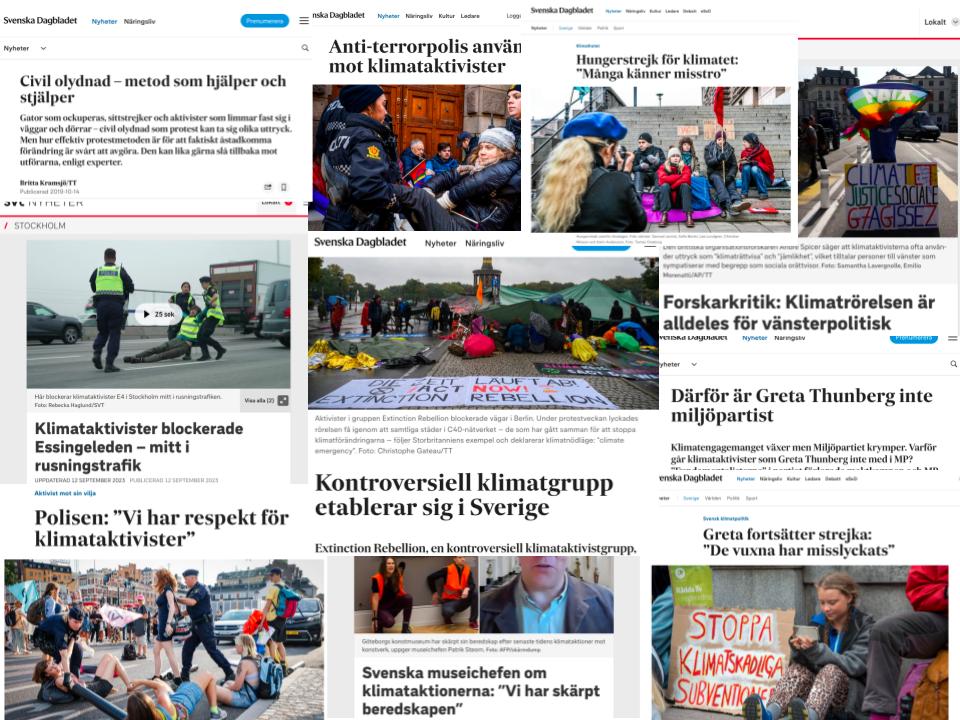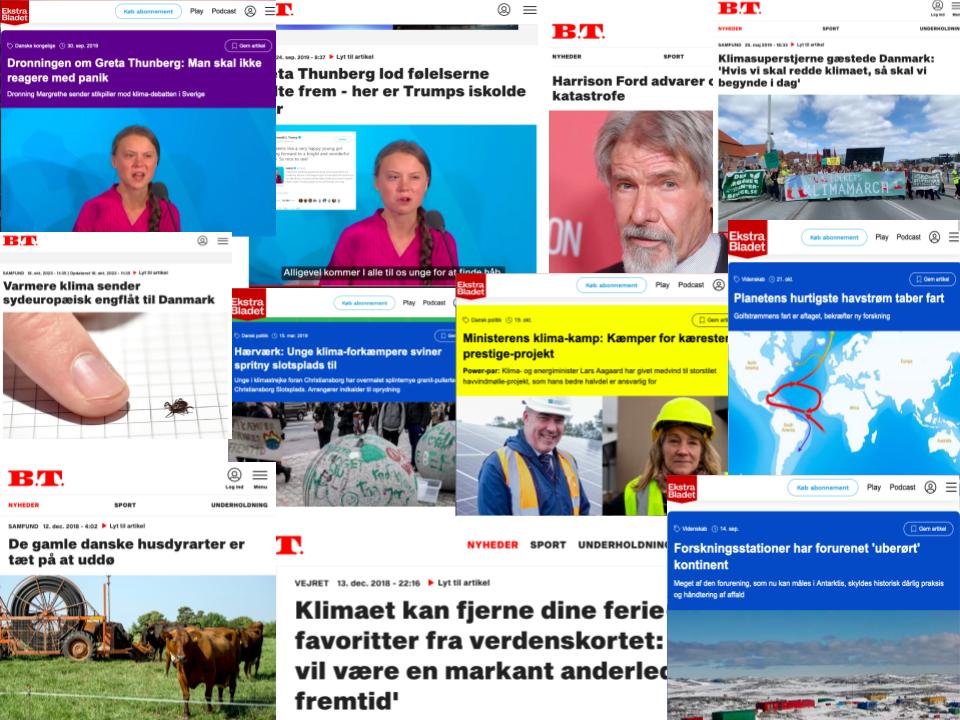Scandinavian countries are often cited as virtuous examples when it comes to the climate debate, but an analysis of the Swedish and Danish media reveals a more complex picture.
The increasing presence of climate change in the Swedish media has given the Sweden Democrats their new focus. The way in which the issue is being discussed, and how it is portrayed as a fear-inducing crisis, feeds into their conservative narrative of nostalgia for a past when things were less complicated.
Similarly, in Denmark, the topic became more popular in the media after 2015 and followed a similar pattern thereafter. However, how climate change and environmental policies are viewed in Denmark has avoided becoming a new point of convergence for the anti-establishment and media-sceptical far-right. Instead of climate change being a huge, terrifying reality that is difficult and frightening to visualise, it has become a call to action and national unity. Nevertheless, activists are pushing for a harsher discourse on climate change in the media as its coverage of the issue is usually described as tame, not reflecting the urgency of the situation.
The cases of Denmark and Sweden serve as two different examples of how the media is failing to address the environmental crisis.
Sweden: Feeding the crisis-hungry far right
The Sweden Democrats’ popularity in Sweden began to grow exponentially thanks to its anti-immigration policies following the immigration waves of the 2010s. But as that issue started to lose some of its traction, climate change came to the forefront.
The climate began to appear more regularly in the Swedish media in 2015. It reached an all-time high presence in 2019, when it was the most reported topic of the year. “What happened in the summer of 2018 is that climate change was felt in Sweden through the record heatwave and severe forest fires” explains Kjell Vowles, a PhD student at Chalmers University specialising in media and climate change. Global warming was no longer a scientific and elusive concept, but people were feeling the direct consequences.
That same year, teenage activist Greta Thunberg became a leader of the climate movement, not only in Sweden but around the world. All this happened in the year of the Swedish elections. The topic quickly moved to the centre of the legacy media agenda. They began to report on issues such as corporate accountability and actions. But the issue that took centre stage was climate activism. This gave the far-right a new front on which to build its anti-establishment discourse and attract new supporters. “The far-right made immigration the first big polarising issue, and now it’s climate change. It’s the same anti-establishment discourse of a globalist elite who wants to change the way we live,” says Vowles.

A patchwork of headlines from Svenska Dagbladet and Sveriges Television. From 2018 to October 2023 they have published articles dealing with or mentioning climate activists a combined total of 1452 times. That is almost 6 articles a week that talk about environmental activists.
Five years on, the climate is still present, although not to the same extent, after the pandemic in 2020 knocked it off the top of the media agenda. Nevertheless, “the polarisation around climate change is becoming more apparent,” says Vowles.
The rapid rise of climate change in the mainstream media and the focus on activism paved the way for the introduction of the issue in alternative, far-right media.
The rapid rise of climate change in the mainstream media and the focus on activism paved the way for the introduction of the issue in alternative, far-right media. Climate change was barely present before Greta Thunberg. She became an easy target for the extreme right and the Sweden Democrats. They argued that Swedish politics was being infantilised by following what a 15-year-old girl was saying instead of experts on the issues. Essentially, their argument was that “Sweden was moving from being a rational society to an emotional one,” says Vowles.
Although Vowles recognises that this new alternative media was at the centre of Sweden’s growing polarisation on climate change, the legacy media also contributed to this polarisation. Their extensive coverage of activists and the alarmist way they presented the issue, rather than focusing on the science and what to do next, led to an immense backlash.
What Danish politics got right and what the media got wrong
The trend in climate coverage in Denmark is similar to that in Sweden. It peaked in 2018. That year, activists took to the streets and put a huge amount of political pressure on the 2019 elections, while the media constantly pressed the issue. However, this didn’t lead to a backlash from the far-right, nor did climate become a polarising issue.
A study conducted in 2022 by Denmark’s green think tank CONCITO showed that 88 per cent of Danes see climate change as a serious problem. Similarly, “66 per cent say that politicians’ efforts to tackle climate change will influence who they vote for in the next general election”.
Mads Ejsing, a postdoctoral fellow at the Center for Applied Thinking at the University of Copenhagen who specialises in environmental policy, explains that there are two reasons the general Danish population cares about climate change. The first is education, which has a strong focus on environmental issues. The second is the way in which resources and climate policy have been developed. Climate action in Denmark began in the 1990s with the introduction of wind turbines and new types of renewable energy. Rural areas, where far-right and climate denialist ideas tend to emerge, also benefitted economically from these changes.
The debate around climate has been part of the Danish political landscape for more than three decades and has affected all sectors of society in both positive and negative ways. The discourse around the issue is particularly rooted in urban areas, but also calls for action across society. This not only unites the Danish people, but also avoids the creation of the classic discourse adopted by the far-right parties of labelling climate change as a problem created by the elite.
Coverage of the climate crisis in Denmark is relatively tame and hasn’t been a driver of debate in the way that movements and activists have been.
Ejsing explains that the media plays a role in bringing the issue of climate change to the forefront of the Danes’ agenda, and that it appears more regularly than in other countries. Nevertheless, he believes that coverage of the climate crisis in Denmark is relatively tame and hasn’t been a driver of debate in the way that movements and activists have been. Fridays For Future, Extinction Rebellion, and the Green Youth Movement have been key to introducing the Danish public to the scale of the environmental crisis.

A patchwork of headlines from Danish tabloids Ekstra Bladet and B.T. These articles all deal with climate change but not from an environmental crisis standpoint. Instead, they focus on trending topics like what celebrities think about the issue, Greta Thunberg’s emotions and sensibilities, an increase in allergies, and how climate change can affect your vacation plans.
After the elections in 2019 and the pandemic in 2020, the climate conversation lulled and was replaced by other trending topics. However, there is currently a sense of urgency, as the 2025 emissions reduction target is not being met. Moreover, in a society where climate denial is condemned, other forms of climate inaction are beginning to be tolerated. “Climate scepticism is not popular, but discourses of climate delay are. That’s what pushes back the targets and takes away the sense of urgency,” says Ejsing.
Activists are beginning to find ways to hold the market accountable for failing to meet these targets, and pressuring the media to present climate change as a crisis and an urgent emergency. A movement called Clear the Agenda is mobilising with the aim of changing the media narrative on global warming from one of mostly bland coverage to one that actually shows the seriousness and urgency of the situation. “A lot of people care about the [climate change] agenda, but that’s not the same as supporting the kind of climate policies we need. And it’s not the same as understanding and feeling the urgency of the situation we’re in,” Ejsing adds.
The media must understand the circumstances
Climate change and environmental policy will be at the forefront of the upcoming European elections in 2024. This could be a make-or-break moment for the environment, not only in Europe but in the rest of the world as well. Sweden and Denmark serve as very different but fitting case studies of how the media is failing the environment and climate action.
The sudden and rapid increase of climate change topics in the Swedish media in 2018 and 2019 created a strong backlash. Framing the issue as a terrifying, all-encompassing crisis and focusing mainly on activists and movements at a time when conservative ideology was extremely popular didn’t help the environmental cause. The media’s focus on the actions of climate activists rather than the changes they are calling for has unwittingly fed the Swedish far-right’s rhetoric and supporters.
Denmark is an anomaly at a time when far-right parties are gaining support in Europe and climate scepticism is at an all-time high: the far-right Danish People’s Party is losing support and most of the population is in favour of climate action. But the rather dull and ineffective discourse in the media is not driving the change people want to see. Ideas that delay climate action are becoming more popular, and the targets that Denmark should reach in 2025 are still very far away. The Danish media is not taking advantage of the overall positive attitudes of Danish people towards climate action to use science and evidence and push for a stronger change in society.
This article is part of the Climate in the Media series, dedicated to climate discourse in the European media. This project is organised by the Green European Foundation in collaboration with Voxeurop and with the support of the European Parliament to the Green European Foundation. The EU Parliament is not responsible for the content of this project.
